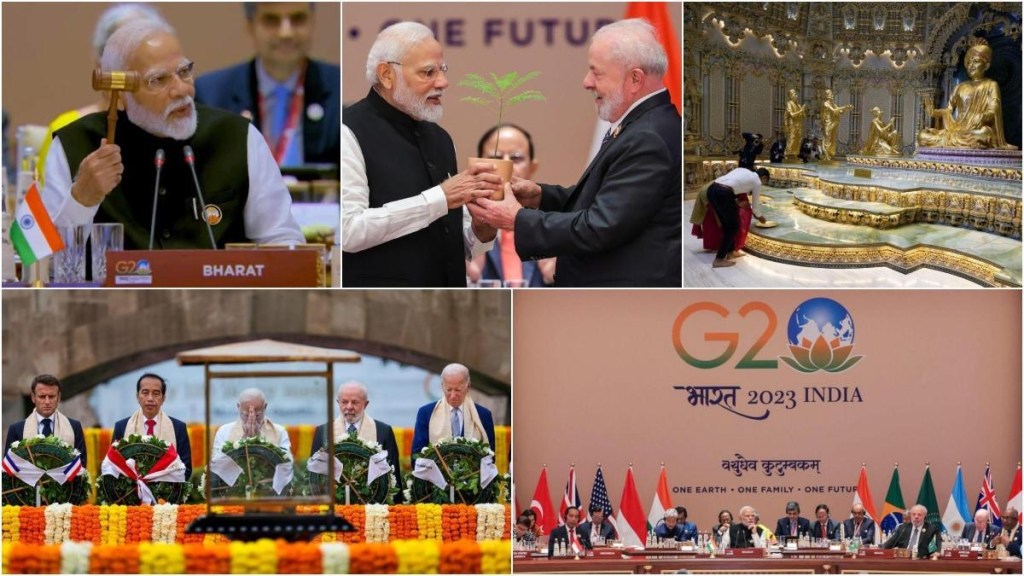The New Delhi G20 Summit, the 18th since the grouping of Finance Ministers and Central Bank Governors (FMCBG) was elevated to the Leaders’ level, is done and dusted. How is the Summit likely to be remembered going forward? India had never hosted, let alone chaired, such a high-level international meeting with all G7 leaders. The absence of president Putin of Russia and president Xi Jinping of China took some sheen off the event. It nevertheless accentuated India’s growing geopolitical clout, and its hard image as a rising power and counterweight to China, at a time its growth is expected to overtake that of China. But it might have also diminished its soft power.
The success or otherwise of a G20 Summit rests on the Communique issued by Leaders. It is difficult for most people, other than camp followers of the G20, to navigate humongous and dense Leaders’ Communiques, replete with guarded ‘diplomatese’, spread over scores of paragraphs and several pages. It contains nuanced distinctions between ‘noting’, ‘acknowledging’, ‘welcoming’ ‘supporting’ and ‘endorsing’ various proposals and reports that can cleverly conceal differences rather than indicate full consensus.
The G20 also has an ongoing agenda with multiple workstreams that pass from one Presidency to the next. That it has become the practice to reiterate what had been agreed in earlier communiques in subsequent ones has only compounded the problem of assessing where tangible new progress, beyond statement of intent, has been made. In any case the G20 has no enforcement mechanism, and it is mostly left to the countries themselves to implement what they have agreed to.
Each Presidency takes distinctive new initiatives, and these are duly incorporated in the text. The Communique ‘noted’ several initiatives taken by the Indian Presidency, such as the bio-fuels alliance, climate finance (where the ambitious numbers cited are eye-popping compared to what has been mobilised so far), volume 1 of the Experts Group report on MDBs (multilateral development banks), digital public infrastructure, women’s empowerment, etcetera. To what extent these initiatives are implemented would depend on voluntary actions by the G20 countries themselves, whether they get on to the agenda of bilateral and multilateral lending agencies, and how subsequent Presidencies carry these forward.
With the passage of time, however, the paragraphs for which the Delhi Summit is most likely to be remembered are paragraphs 7-14 on the War in Ukraine, paragraph 76 that admitted the African Union (AU) as a permanent member of the G20, and the intriguing paragraph 78 on freedom of religion, expression and association.
The first two are manifestation of the India’s growing hard power in global affairs. India made speaking on behalf of the Global South one of its priorities, and the admittance of the AU under its watch is a signal success for the Presidency. This was no doubt made possible by tailwinds behind the proposal, with all major players in the G20 already on board.
The paragraphs on Ukraine, on the other hand, faced strong headwinds to the consensus language finally adopted. It was widely expected that the New Delhi Summit might be remembered as the first G20 Summit where Leaders refused to sign up to an agreed Communique. The Indian Presidency was however able to finesse its Summit with an agreed Communique under challenging circumstances, which is a major achievement and indicative of its growing geopolitical clout. It had thus far been unable to get a consensus communique issued in any G20 meeting under its Presidency on account of hardening positions on the Ukraine war, which no longer made the strong language agreed by G20 Leaders at the Bali Summit acceptable to Russia and China.
That the Presidency was finally able to forge an even-handed consensus on Ukraine is indicative of both deft diplomacy and a weakening of the headwinds working against such consensus. Only time will tell whether president Xi Jinping did not attend the New Delhi Summit on account of bilateral or other geopolitical reasons. But the absence of two major players made the Delhi gathering look like a G7 outreach meet. This, along with recent expansion of BRICS to include two more G20 countries, and some African and West Asian countries, might have persuaded Western countries to be more flexible on Ukraine, lest Russia and China effectively exit the G20 and set up a rival system of global governance, raising prospects of a new cold war. India stood at the junction of both axes, and it was important to make its Presidency a resounding success to try to make it tilt towards the West.
While no country is mentioned in paragraph 78, this is not a legacy paragraph carried forward from the last Communique. Religious universalism is something that the Indian leadership should reflect and act on if it wishes to retain India’s soft power. Apart from Japan and China, all G20 countries have strong Muslim and Christian constituencies. It is also pertinent to note that the former prime minister, while lauding his successor’s conduct of the G20 Presidency, and exuding confidence in the country’s economic prospects going forward, added a word of caution that this was contingent on maintaining social harmony.
The spillover of domestic politics and the impending general elections on G20 meetings and the Summit, with thousands of hoardings, including the persona of the prime minister, is not the norm for G20 meetings that involve hardnosed negotiations behind closed doors. India is by far the poorest in GDP per capita, and with the lowest Human Development and Global Hunger Indices, amongst G20 countries. But it spent much more on hosting the event than its predecessors. The effect of sprucing up on the poor that inhabit these public spaces was not lost on external visitors as it gave the impression of hiding reality. All this did little to enhance the soft power of what is touted as the world’s largest democracy.
The author is former Secretary, Prime Minister’s Economic Advisory Council, and an Indian interlocutor across several G20 Summits.

